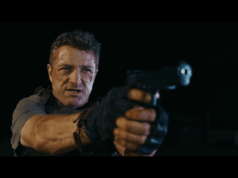“…the film is constantly unsettling and often dark, capturing its characters from a troubling angle and a disturbing point in their lives.”
Within the first two minutes of Joe Swanberg’s 24 Exposures, Swanberg attempts something he has never really attempted — an aerial long shot that fixates on a naked woman, dirty, beaten, and tied, lying lifelessly next to a small river in a muddy patch. The camera focuses on her before zooming out to reveal a small, controlled camera crew, before stopping amongst the tree-branches and pivoting to show a cabin residing in the woods all in one enticing take.
Cut to Billy (Adam Wingard, who directed last year’s slasher You’re Next), a fetish photographer who has made a career out of staging bloody, frequently disturbing photo-shoots featuring nude, pale women lying dead or abused to make for erotic art. Billy often works alongside his girlfriend (Caroline White) and a couple other models (Sophia Takal and Helen Rogers) in order to provide a feeling that is close-to-home and personal, even though he seems to be impersonal and cold, almost like his photos.
- 24 Exposures
- Written & Directed by
Joe Swanberg - Cast
Adam Wingard, Simon Barrett, Helen Rogers - Release Date
24 January 2014 - Steve’s Score: 9.5/10
One day, a depressed, disillusioned detective named Michael (Simon Barrett) shows up at his door, revealing disturbing news that a model he had hired was found murdered and they are in search of suspects. Billy doesn’t seem fazed in the slightest by the news, but cooperates completely with Michael, with the two become friends stuck in some sort of romantic rut. Michael has been battling depression for years, with a relationship that has just collapsed and nowhere to really turn. Billy is struggling to keep his relationships from falling into the coldness of his photography.
24 Exposures is a perfect follow-up to Drinking Buddies (despite being shot before), Joe Swanberg’s claim to a more mainstream fame. Drinking Buddies depicted a lighter side of Swanberg — a side that seemed much more optimistic and brighter, yet still presented us with the side of him that was about the vividly-drawn characters and the enticing drama. 24 Exposures, on the other hand, is a totally different animal. Very similar to Swanberg’s 2011 effort Silver Bullets, which occupied the same psychological moodiness mixed with horror undertones, the film is constantly unsettling and often dark, capturing its characters from a troubling angle and a disturbing point in their lives. The two films are incomparable from a genre/thematic standpoint, but show Swanberg continuing along the track of artistic growth.
The relationship of Billy and Michael is the core of the film, showing two souls that were broken in different ways but are still trying to play the cards they are dealt. Wingard proves to not be a completely likable protagonist but an interesting one, only elevated when working with Barrett to show the beauty of his naturalistic acting style.
*****
The other center of the film can be seen as an ode or potential commentary on the photography-industry and its relative blandness and interchangeability over recent years, with cameras coming equipped on every phone, almost devaluing the medium for veterans. Returning to my point about Billy and Michael’s relationship, a great scene takes place in a bar between the two men, as they drink and Billy — carrying the conversation — talks about how so many aspiring photographers flock to the same, boring botanical gardens to capture indifferent shots of the same plants growing, living, and dying to store on their hard-drives, the same place where millions of other photos looking practically identical exist. There is no originality, and by participating in fetish photography, Billy knows he is doing something different and at least likes what he’s doing. He can’t really tell you why, but he likes it, presumably for its originality and the fact that few other people would spend time crafting often-disturbing shots of nude women soaking in a bathtub of blood.
Between the brewing relationship between two broken men, the intelligent look on the photography industry, and, finally, the constant unsettling qualities 24 Exposures practically oozes, the film hits the ground running in the best possible way. Swanberg throws many ideas into a pot, stirs them heavily, and creates a concoction that is part-crime drama, part mood piece, and part horror film that all work together to create something strong and subtly effective, rather than meshing three parts that could easily work against each other. Swanberg has come a long way since 2005, creating simple dramas with basic camera angles that screamed “do-it-yourself.” Now, he tackles a multi-genre project with erotic and fetish undertones that is one of the most ambitious works he has yet to do. His commitment and determination are easily commendable, but his success is almost unheard of.
There are, however, some people who may not want to subject themselves to this film, and to that, don’t fear — there’s likely a garden nearby.
Review by Steve Pulaski, Lead Film Critic







